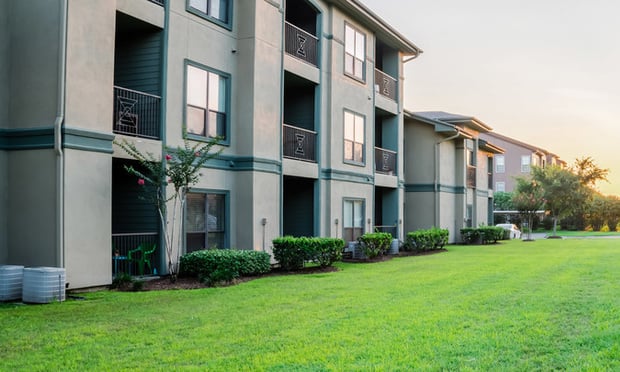DALLAS—The Dallas and Fort Worth apartment markets continued with steady performance in November, but the amount of new supply coming to the metroplex may have a negative impact in 2017, according to Axiometrics, the apartment and student housing market research and analysis firm.
“DFW has been one of the few markets to maintain its strength in the past year as moderation hit the nation as a whole,” said Jay Denton, senior vice president of analytics for Axiometrics. “But new supply is expected to reach its peak for this cycle in 2017 while demand in terms of job growth will remain steady. It's that influx of new construction that could cause rent growth to decrease.”
Axiometrics forecasts annual effective rent growth to average 2.7% in Dallas and 2.9% in Fort Worth in 2017, as 29,056 new units have been identified for delivery to the metros next year (24,454 in the Dallas-Plano-Irving metropolitan division). In comparison, 19,028 were delivered in 2016 (16,781 on the Dallas side).
“Job growth is the major driver of population growth. In DFW, the correlation between lagged job growth and population growth is close to 65%. This allows for increased renter household formation, which helps apartment market fundamentals,” Axiometrics' economics team tells GlobeSt.com. “Job and population growth in the DFW metro area remain robust as of 2016, allowing the metro to absorb heightened new supply. An increase in job openings versus slower hiring to fill those positions has been a national issue, not unique to DFW. Despite the skills mismatch, the DFW area has been able to fill open positions at a higher rate than national due to good universities in the metro area. Furthermore, the area attracts new residents and businesses from all over the country and internationally due to lower cost of living and lower cost of doing business.”
Job growth is predicted to remain above 3% in Dallas and stay around 1.5% in Fort Worth. Effective rent in the Dallas metro was 4.3% higher in November 2016 than it was in November 2015, while rent growth was 5.7% in Fort Worth. November occupancy rates were higher than October's in both Dallas and Fort Worth, which is common late in the year. As previously reported, rent growth for Dallas was also reported to be at a high rate back in October.
“Despite healthy job and population growth next year, we are expecting some moderation in rent growth in 2017 because of the large amount of new supply,” Axiometrics' economics team tells GlobeSt.com. “We expect occupancy to average about 94.7% and annual average rent growth of 2.8% in 2017. The major cause of this moderation in growth is the approximately 28,000 new apartment units expected to come to the DFW market next year.”
Several economic factors have resulted in net positives for the multifamily sector and prices in core markets are at an all-time high. But just how long can the market continue on this trajectory? Join us at RealShare Apartments East on Feb. 28 and March 1, 2017 for insights on succeeding in the right markets as well as navigating and finding opportunities in the more challenging ones. Learn more.
DALLAS—The Dallas and Fort Worth apartment markets continued with steady performance in November, but the amount of new supply coming to the metroplex may have a negative impact in 2017, according to Axiometrics, the apartment and student housing market research and analysis firm.
“DFW has been one of the few markets to maintain its strength in the past year as moderation hit the nation as a whole,” said Jay Denton, senior vice president of analytics for Axiometrics. “But new supply is expected to reach its peak for this cycle in 2017 while demand in terms of job growth will remain steady. It's that influx of new construction that could cause rent growth to decrease.”
Axiometrics forecasts annual effective rent growth to average 2.7% in Dallas and 2.9% in Fort Worth in 2017, as 29,056 new units have been identified for delivery to the metros next year (24,454 in the Dallas-Plano-Irving metropolitan division). In comparison, 19,028 were delivered in 2016 (16,781 on the Dallas side).
“Job growth is the major driver of population growth. In DFW, the correlation between lagged job growth and population growth is close to 65%. This allows for increased renter household formation, which helps apartment market fundamentals,” Axiometrics' economics team tells GlobeSt.com. “Job and population growth in the DFW metro area remain robust as of 2016, allowing the metro to absorb heightened new supply. An increase in job openings versus slower hiring to fill those positions has been a national issue, not unique to DFW. Despite the skills mismatch, the DFW area has been able to fill open positions at a higher rate than national due to good universities in the metro area. Furthermore, the area attracts new residents and businesses from all over the country and internationally due to lower cost of living and lower cost of doing business.”
Job growth is predicted to remain above 3% in Dallas and stay around 1.5% in Fort Worth. Effective rent in the Dallas metro was 4.3% higher in November 2016 than it was in November 2015, while rent growth was 5.7% in Fort Worth. November occupancy rates were higher than October's in both Dallas and Fort Worth, which is common late in the year. As previously reported, rent growth for Dallas was also reported to be at a high rate back in October.
“Despite healthy job and population growth next year, we are expecting some moderation in rent growth in 2017 because of the large amount of new supply,” Axiometrics' economics team tells GlobeSt.com. “We expect occupancy to average about 94.7% and annual average rent growth of 2.8% in 2017. The major cause of this moderation in growth is the approximately 28,000 new apartment units expected to come to the DFW market next year.”
Several economic factors have resulted in net positives for the multifamily sector and prices in core markets are at an all-time high. But just how long can the market continue on this trajectory? Join us at RealShare Apartments East on Feb. 28 and March 1, 2017 for insights on succeeding in the right markets as well as navigating and finding opportunities in the more challenging ones. Learn more.
Want to continue reading?
Become a Free ALM Digital Reader.
Once you are an ALM Digital Member, you’ll receive:
- Breaking commercial real estate news and analysis, on-site and via our newsletters and custom alerts
- Educational webcasts, white papers, and ebooks from industry thought leaders
- Critical coverage of the property casualty insurance and financial advisory markets on our other ALM sites, PropertyCasualty360 and ThinkAdvisor
Already have an account? Sign In Now
*May exclude premium content© 2024 ALM Global, LLC, All Rights Reserved. Request academic re-use from www.copyright.com. All other uses, submit a request to [email protected]. For more information visit Asset & Logo Licensing.









